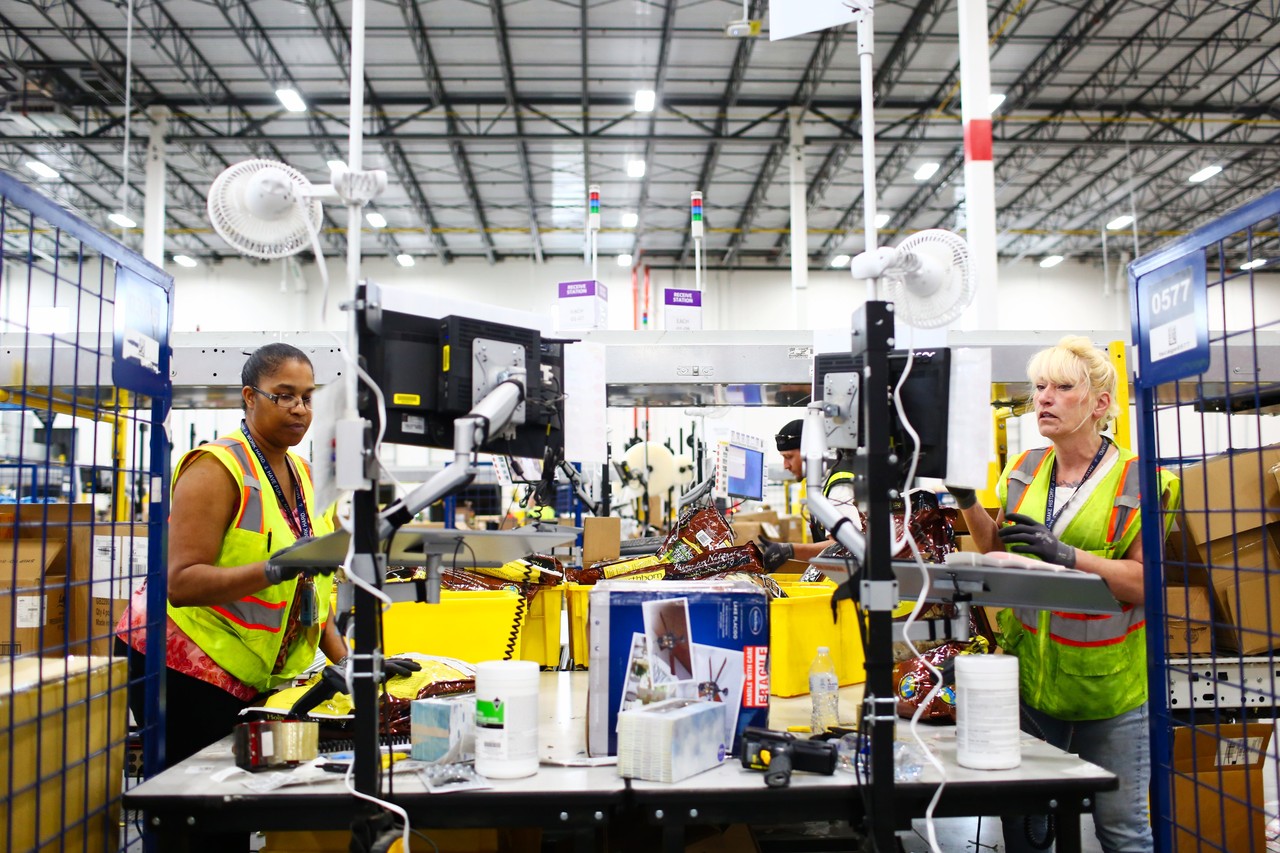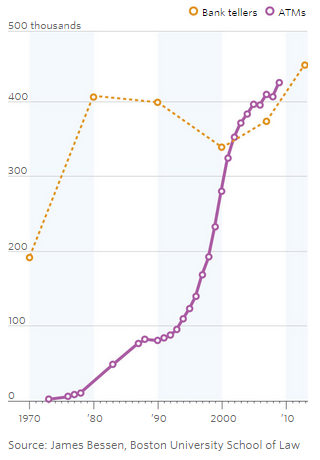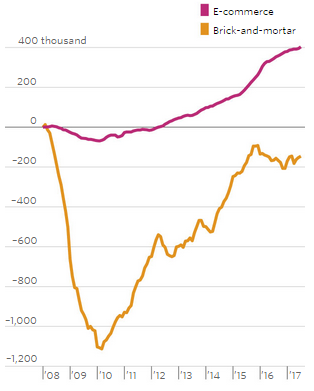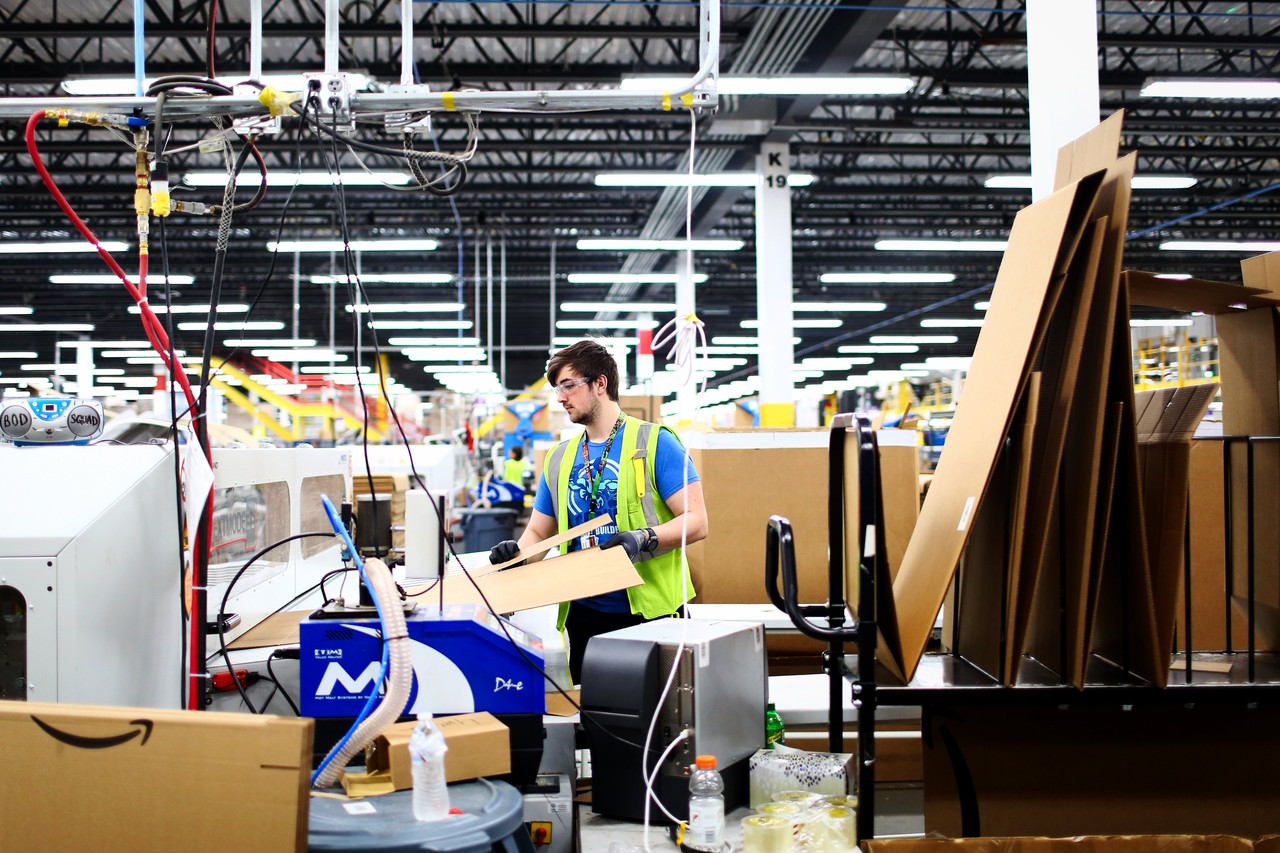Automation usually creates more jobs with higher pay than it destroys. Example: US Retail.

For retail companies, the robotization apocalypse is not science fiction. Digital giants are capturing an increasing share of consumer spending, thousands of stores are closing, and tens of thousands of their employees are losing jobs.
One of them is Belinda Dupier, who sold jewelry at the Sam's Club store in
Fall River , Massachusetts [the former main center of the textile industry in the US - approx. trans.]. In early 2016, the store, trying to stay afloat, closed.
But Dupier, who has lived all her life in a once-thriving town formed around a factory and an hour south of Boston, has turned from a victim of the digital revolution into a beneficiary. Amazon.com Inc announced the future hiring of 500 full-time employees for its new assembly warehouse in the backyard of the city. “I was dying of impatience, waiting for the opening of the Amazon,” she recalls. She was one of the first people hired to work there last fall; since then, the number of employees has risen for a full day to 2,000 people.
Dupier earns $ 2 per hour more at Amazon than at Sam's, in part because of increased productivity. In Sam's, she could serve from 1 to 20 customers per day. At Amazon, it packs from 75 to 120 boxes per hour, which are then carried away by a high-speed automatic conveyor in the direction of a whole fleet of trucks moving around the region. The work is physically more difficult, but Dupier, who turned 54, is looking for positive aspects. “At this job I dropped 11 kg,” she says. “This is a free gym.”
The fall in physical retail stores has been accompanied by an online media boom that is not so much in the media, which has created more jobs in the US than was lost along with retail stores. And in these places they pay more, because employees work more productively.
This is an example of what is usually missed in disturbing messages about how jobs will be destroyed by robots, artificial intelligence and other forms of automation. Throughout history, automation has usually created more jobs with better pay for work than it destroyed. The reason: companies do not use automation just to do the same thing cheaper. They find ways to offer completely new and improved products. After customers fly to these offers, companies have to hire more people.
 At Amazon's packing warehouse, computers tell employees the exact amount of packaging they need.
At Amazon's packing warehouse, computers tell employees the exact amount of packaging they need.Robotopocalypse is a new phenomenon, but similar unrest is rooted in past centuries. In 1589, Queen
Elizabeth I refused to grant a patent to the inventor of the automatic knitting machine, fearing that this would leave knitters out of work. In 1930, the British economist
John Maynard Keynes warned of the emergence of "technological unemployment due to the fact that ways of saving on labor will outpace the speed with which we will find new ways to use labor."
These fears were periodically unfounded. James Bessen, an economist at the School of Law at Boston University, found many examples of how technology, which was supposed to destroy jobs, had the opposite effect. After installing the first automatic ATMs in the 1970s, the director of Wells, Fargo & Co. predicted that ATMs will lead to a decrease in the number of branches of banks and employees of these branches. Indeed, on average, in 2004, a third of the fewer employees worked than in 1988. However, Bessen found that ATMs cheapened the content of the branch, which is why they were opened more often. The total number of branches has increased by 43% since then.
 Orange - the number of bank employees, purple - the number of ATMs
Orange - the number of bank employees, purple - the number of ATMsToday, more employees work in banks than in the 1980s, and their responsibilities have expanded to services not available to ATMs — for example, selling additional services to a client.
Bessen himself witnessed such a transformation. In 1983, he created an early prototype of a computer publishing program that facilitated work with fonts and graphic design. He recalls that after Sears acquired this program in 1989, she fired about 100 employees. He was worried: “does this program really lead us to fire a bunch of people?”
But some clients used this program to increase the number and variety of their publications. The A & P supermarket chain used this software to publish 30-40 versions of its weekly catalog, in which various discounts were offered for different areas. Bessen found that in the 1980s, the number of employees of printing houses decreased by 100,000 people, and from 1979 to 2007 the number of graphic designers increased more than fourfold, to 800,000, which more than offset the losses.
Automation begins to reduce the total number of people employed only after the industry fully satisfies the market demand - as happened with cars.
But this process, of course, has a destructive side: people who have lost their jobs because of automation turn out to be completely not the ones who go to work in new types of industry made possible by automation. But over time, the overall effect is still positive.
But even economists and technologists who are familiar with history are worried that this time everything will be different, because today's technological breakthroughs allow us to do things that were previously considered to be a field of human activity only. Microsoft co-founder Bill Gates proposed taxing robots to slow down their potential for destroying jobs. Ilon Mask of Tesla Inc wants the government to handle artificial intelligence regulation.
And yet, there is no evidence of the occurrence of the apocalypse, and there is quite a lot of evidence for the opposite result. In many cities, it is cheaper and easier to order a car from Uber or Lyft than a taxi, and as a result, the number of rides and drivers has increased. From 2015 to the first half of 2017, the number of trips on yellow taxis in New York decreased by 75,000, but the number of trips to Uber and Lyft increased by 210,000, according to calculations by the commission on taxis and limousines published by blogger Todd Schneider. This suggests that joint trips opened a new demand item, made traveling by car cheaper, and finding them easier - especially in places where taxis were hard to find.
 Dynamics of the number of jobs in e-commerce (purple) and normal retail (orange)
Dynamics of the number of jobs in e-commerce (purple) and normal retail (orange)Retail sales are the largest industry in the US that is under attack from digital technology, but there is evidence that online sales did not reduce the total number of seats, but rather increased it. Indeed, thousands of stores have closed. From late 2007 to mid-2017, regular stores lost about 140,000 full-time jobs, according to a report by Michael Mandel from the Institute for Progressive Policies. Over the same period, a total of 126,000 jobs appeared in online sales.
However, Mandel notes that the last figure does not include packing depots, such as the one recently opened in the Fall River - their Bureau of Labor and Statistics takes them into account under warehouses and storage. He notes that according to reports from this bureau in Kentucky, in 2016 there were only 3,213 e-commerce workers, although Amazon has 12,000 employees on this state. Warehouses since 2007 have added 274,000 jobs across the country. Mandel believes that all of them can be attributed to the packaging warehouses, so the number of jobs in online sales increased by 401,000 - three times more than disappeared from retail. Mandel calculated that packing warehouses pay workers on average 31% more than retail stores in the same locality.
All this raises important questions. If online sellers are more productive than regular stores by the number of sales per employee, how can they increase the number of jobs in general? And how can they pay more and not raise prices?
The answer is rather complicated. In fact, the total number of jobs in sales could grow faster without e-commerce. In a critical report on Amazon, the Local Self-Sufficiency Institute claims that the firm’s high productivity results in 149,000 jobs not appearing in retail sales that would have arisen in the absence of this company.

But the main reason is that online sales do not just sell the same products as stores, only cheaper. They allow buyers to consider a huge range of products and choose exactly what they need, and then get them with delivery in one to two days, saving time, cost and inconvenience associated with trips to several shops. Mandel believes that online sales save an average adult 15 minutes a week. Just as Uber and Lyft discovered the hidden demand for travel, online sales discovered the hidden demand for purchases from home. These properties do not necessarily increase the price - as they do not increase its improvements in the design of cars or household appliances. However, with online sales, people use more retail services than in the previous era.
And consumers often pay for this convenience. John Blackledge, an analyst at Cowen & Co., estimates that 42% of US households, 53 million, are subscribed to Amazon Prime, which gives them free delivery for 1-2 days, and in some cities - delivery on the day of purchase, and set other amenities for $ 99 per year. Prime subscribers typically place twice as many orders as other buyers, according to Blackledge’s estimates. To increase demand, online stores use their efficiency to absorb most of the cost of delivery. Amazon uses product-earned margins to build and support logistics structures that provide profitable customer service.
The scope of this investment becomes apparent after a visit to the Fall River Center, which handles large and substandard items such as household appliances, bicycles, tires, and even boat anchors.
When a box of frying pans arrives at the warehouse, workers do not put them on the rack for the frying pans. They lay out separate pans where they fit. The location of each pan is scanned and goes into inventory. When a customer places an order for a griddle, the Amazon program searches for it among 70 assembly stores and selects the one from which it will be the cheapest or fastest to deliver. If it is located at the top of one of the 10-meter racks in a certain row of the center, then the order appears on the scanner screen of the nearest collector. His forklift, guided by wires in the floor with the help of electric sensors, will lift it up and lift it to the desired location of the rack.
Assemblers will transport these items in metal cages to a packing section where computers will tell packers what kind of box size should be used for ordering, or transfer its dimensions to devices that cut boxes into special sizes. After packing the order, Dupier and her colleagues, the box will travel on a conveyor belt, will be weighed on a scale checking the weight and contents, then under the scanner, which will print and paste a sticker with the address. After a few hundred meters and a few seconds, the boxes will automatically roll off the conveyor next to the truck going to the client’s city.
 The worker cuts a box of the desired size.
The worker cuts a box of the desired size.People are used in this process, and often in physically demanding work, but Amazon’s technology greatly increases the number of orders that can be packaged and delivered — all of which reduces the length and cost of delivery. Constant improvements and a growing network of assembly warehouses give customers the opportunity to place an order even at 23:59, and still get it in two days.
This work is simple, as reflected in the salary. The initial payment in Fall River ranges from $ 13.05 to $ 13.55 per hour. But, taking into account the processing fees received by all employees of the company's shares, and additional bonuses, the amount is comparable to what was once paid at local textile mills, says Kenneth Fiola, vice president of the City Economic Development Agency. It also turns out more than the salary of traditional stores, which usually pay the minimum for a staff of $ 11 / hour.
“Most of our employees didn’t have any experience in working in a warehouse, managing a loader or industrial equipment — and we provide them with these skills, we train, we train in a new way of retail sales,” said Andrew Lightman, general manager of the assembly warehouse.
Like Dupier, Tarra Tripp also worked in the store, and worked on decorating the cakes at the family grocery store. At Amazon, she works with a machine that cuts the size of boxes for things of unusual shape. This is not high technology, but there are still more technologies than in her previous work, she says, "unless you think that cutting bread is a very technological process." The salary is a little more, and in four days she works out hours for the whole week, which gives her three days off during the week. She is not going to spend her entire career here, and soon plans to go to study at the veterinary technician - Amazon will be involved in tuition fees.
There are both pros and cons to Amazon's arrival in Fall River. The city has notoriety - here
Lizzy Borden was accused of killing her father and stepmother - and the glory of the textile center of the country. Textile factories attracted uneducated migrants from France, Portugal and Poland along with their children.
Back in 1991, the city could boast 20,000 work in production. But by 2015, this number had fallen below 4,000, because jobs had moved south and then overseas, or were automated. Unemployment exceeds 6%, which is more than the average for the country and for the state.
City officials rolled out a red carpet for Amazon, offering big discounts on taxes and good location. The company's arrival was the largest increase in the number of jobs in the memory of local residents.
 Fall River Mayor Jaziel Correira II says Amazon is filling the void left by the textile industry
Fall River Mayor Jaziel Correira II says Amazon is filling the void left by the textile industry“We had people with an unbearable skill set,” says Jaziel Correira II, 25-year-old Mayor of Fall River and the son of immigrants from the former Portuguese territory of Cape Verde. “Where will a man who has been engaged in textiles for 20 years if he is fired?” Places like Amazon fill this void, he says. “They have a chance to work for a Fortune 500 company. This community rarely gets such a chance.”
And while the boom in online commerce is real, the question is whether it will continue. Amazon and similar companies continue to be involved in warehouse automation. The company is studying the use of UAVs for delivery of orders, and explores robomobili. In 2012, Amazon acquired robots manufacturer Kiva Systems and is working to replace assemblers with robots.
However, the day is still far off when Amazon will need fewer hands. The company’s volume is growing so fast that it hires people. So far, the key advantage of robots used at an assembly warehouse in Baltimore is a reduction in the required space, not labor. Products can be stored denser, since robots deliver assemblers directly to objects, and they don’t have to walk between the racks. In Baltimore, the center employs 3,500 people, which is more than 2,500 jobs that existed at the time of its opening in 2015. At the national job fair last month, Amazon accepted 100,000 resumes and already made 40,000 job offers.